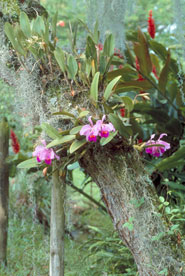|
Welcome to the AOS Beginner�s Newsletter. We will be sending you monthly tips on how to grow orchids and help you get them to bloom again. In addition to the information presented here, we invite you to visit the AOS website at www.aos.org and check out the information found under ORCHID INFORMATION > ORCHID BASICS.

Epiphyte or Terrestrial?
Sympodial or Monopodial?
Understanding where and how orchids grow will help you better understand how to grow them. This newsletter looks at the growth habits of orchids.
The structure of an orchid plant is the same as any plant for it has roots, stems, leaves and flowers. But these parts are adapted to its way of life and differ somewhat from familiar plants which you grow in your garden.
Epiphytes and Terrestrials
Most of the cultivated orchids are epiphytes, such as the Colombian Cattleya trianae pictured above. They do not grow in the ground but instead grow in trees or on rocks. This puts their roots out into the air rather than underground. The word "epiphyte" (EP-ih-fite) means "air plant" or literally "to grow upon a plant". Epiphytes are not parasites. They do not take anything from the host plant. Epiphytes perch upon other plants but get their moisture and nutrients from air, rain and debris. Cymbidiums and other orchids are terrestrial, which means "growing in the ground". The Sobralia pictured at the bottom of the page is a terrestrial orchid. Most of the native orchids of the United States and all the natives of Europe are terrestrials. Some epiphytic orchids have adapted to growing on rocks because nearby forests may not offer enough light. Rock-growing orchids are known as lithophytes.

Sympodial and Monopodial
There are two types of growth found in orchid plants. One growth pattern is called sympodial (sim-POH-dee-al), the other is monopodial (mon-o-POH-dee-al).
For sympodial think of sideways. An orchid with sympodial growth moves sideways. From a connecting stem (rhizome) which grows horizontally, it puts up successive growths in which each one is a duplicate of the one before.
Examine the sketch. The upright growths are called pseudobulbs, each a repetition of the one before and growing parallel to each other. A plant may produce one new pseudobulb at a time, perhaps even only one per year. But it may make two or more growths simultaneously, and a large plant may make several new growths at the same time. Hybrids may have more than one cycle of growth per year.
The majority of the cultivated orchids are sympodial - they grow sideways. New growth begins at the base of the previous mature growth. Cattleya, Oncidium, Dendrobium and Cymbidium are all examples of sympodial orchids.
On the other hand, monopodial (mon-oh-POH-dee-al ) orchid plants grow continuously taller - upwards, and some reach many feet in height under ideal conditions. Think of the vandas, growing outdoors in the tropics. Others have reasonable height limits, such as the phalaenopsis group. Monopodial means "one foot".
A monopodial orchid has neither pseudobulbs nor rhizomes. It grows continually upward from the top of the plant. It produces roots and flowers at intervals from the vertical stem.
Quite in contrast to the foliage habits of sympodial orchids, a monopodial orchid has alternate leaves the entire length of the stem. Lower leaves may fall off as the plant ages. Phalaenopsis, Vanda, Ascocenda and Angreacum are all examples of monopodial orchids.
Greg Allikas
August 2009

Did You Know?
Orchids grow naturally in very diverse environments. They can be found in tropical jungles and in Arctic tundras; in rainforests and dry savannas.
Reinikka, Merle, A History of the Orchid, Timber Press, Portland Oregon, 1995, p. 3.
Right: Sobralia lilastrum growing as a terrestrial in the Gran Sabana, Venezuela
| 
